Space Verdict
It’s incredible to get 10x magnification and image stabilization in such a small package. We rate these binos highly for stargazing on holiday or when traveling but the plastic casing is hard and slips if placed on uneven surfaces.
Pros
- +
Small, lightweight stabilized binoculars
- +
Nice-looking, curvy construction
- +
Great image stabilization
- +
10x magnification keeps up with generalist 10x42 models
Cons
- -
Restrictive eye relief adjustment
- -
Can slip on uneven surfaces
- -
Slip-on eyecups don’t secure to bino body
Why you can trust Space.com
The biggest appeal of the Canon 10x20 IS binoculars is that they are small, light and have image stabilization built-in. That means they’re eminently pocketable and could be one of the best compact binoculars, but they also provide suitable, rock-steady views of stars and nature subjects.
I have also reviewed the Canon 8x20 IS binoculars, which are identical for all but the magnification size (8x instead of 10x) and the fact that the 8x versions are 10 g lighter (420 g versus 430 g excluding the CR123A lithium battery), which I would argue is imperceptible when in use.
Their curved shape is complemented by an anthracite gray color, which is pleasing both to look at and to hold. Despite their portability, they are not waterproof or fogproof. They are water-resistant so use in light rain is permissible but this would only be a problem when stargazing if they are not packed away during showery spells.
Canon 10x20 IS binocular review
Canon 10x20 IS: Design

- Compact and lightweight
- Strap attachments hidden
- Smooth hard plastic does make them prone to slipping on uneven surfaces
I would categorize the Canon 10x20 IS binoculars as compact binoculars in that they are only 10 g heavier and slightly larger than the 8x20 versions, which are the lightest in the Canon image stabilized line-up, at time of writing. I could immediately feel this when using them because they feel lighter than they look. At 430 g without the CR123A battery, they can easily be used handheld for longer periods without fatigue, especially when looking up at the night sky.
The battery is a CR123A lithium unit, smaller than traditional AAA or AA batteries, that slips into the center of the binoculars. I do find they are not as commonly stocked in stores though, so I advise taking spares when traveling.
There is no tripod mount attachment on these binoculars so stargazers with poor hand grip or arm strength may struggle if using for extended periods. However, serious astronomers will likely opt for larger binoculars that have greater magnification and bigger objective lenses that are more suited to night sky observations.
They are cleverly designed though, with the strap attachments hidden underneath the neckline of the eyepieces, sitting flush with body.
Breaking space news, the latest updates on rocket launches, skywatching events and more!
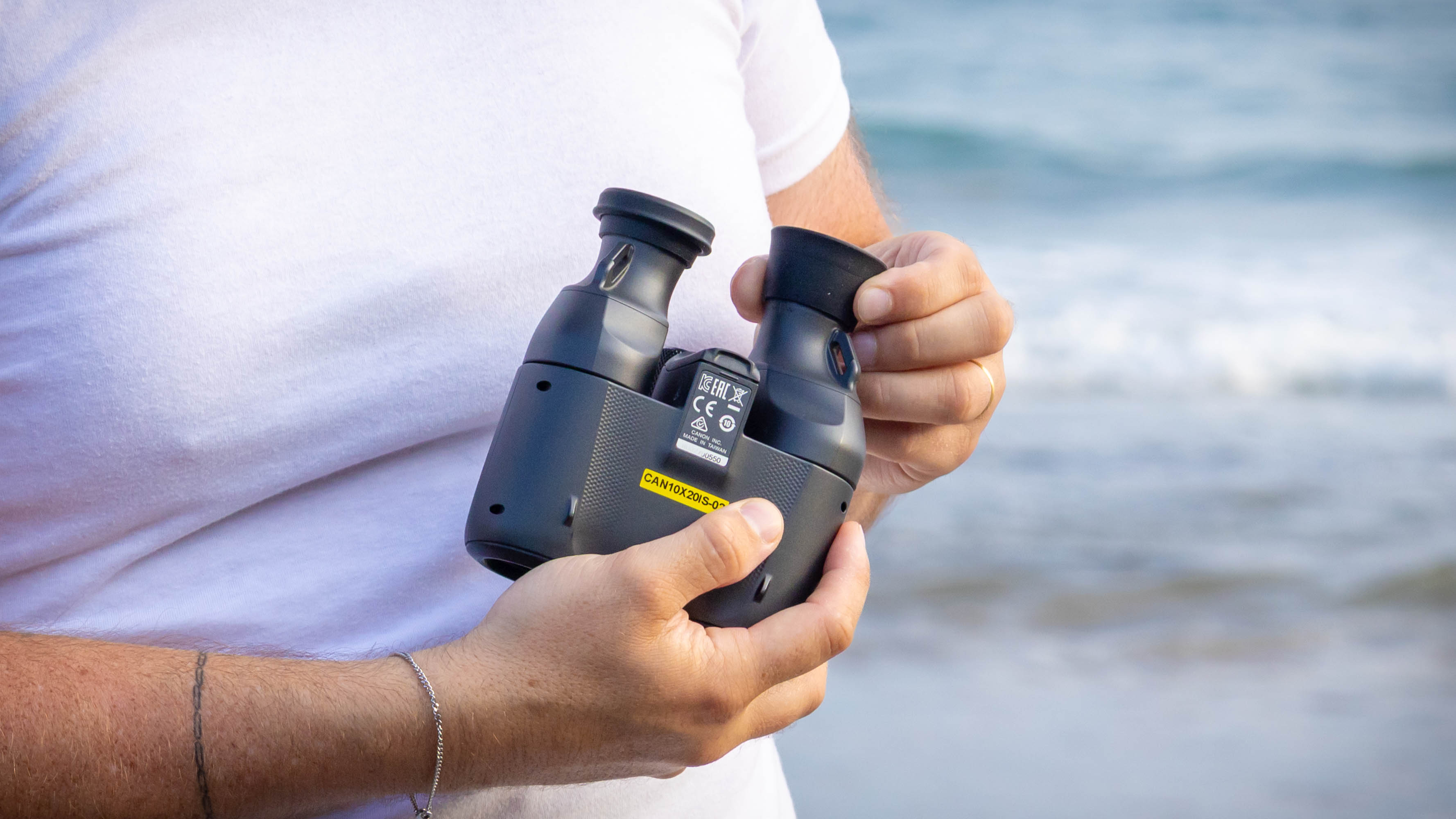
Magnification: 10x
Objective lens diameter: 20mm
Angular field of view: 5.3 degrees
Eye relief: 13.5mm
Weight: 15.2 oz (430 g)
The binocular enclosure is made of hard plastic, which I found to be a blessing and a curse. They are beautiful, smooth and curved, feeling great in my hands. I love the color and think they look stylish enough to display on the shelf at home when not in use. The grip areas (where the hands rest) are dotted with texture to improve grip, but the hard plastic casing can be slippery. That makes it hard to place them down on uneven surfaces like rocks or jaunty fences or posts. I discovered this at the coast, to my detriment, saving them from falling into the sand only by the skin of my teeth. Placing them objective lens-down reduces this issue, as there is a rubber ring around the front edge of the binoculars which prevents them from slipping. But I would discourage readers from doing this on surfaces that are anything but flat, in case the glass front elements become scratched.
Canon 10x20 IS: Performance
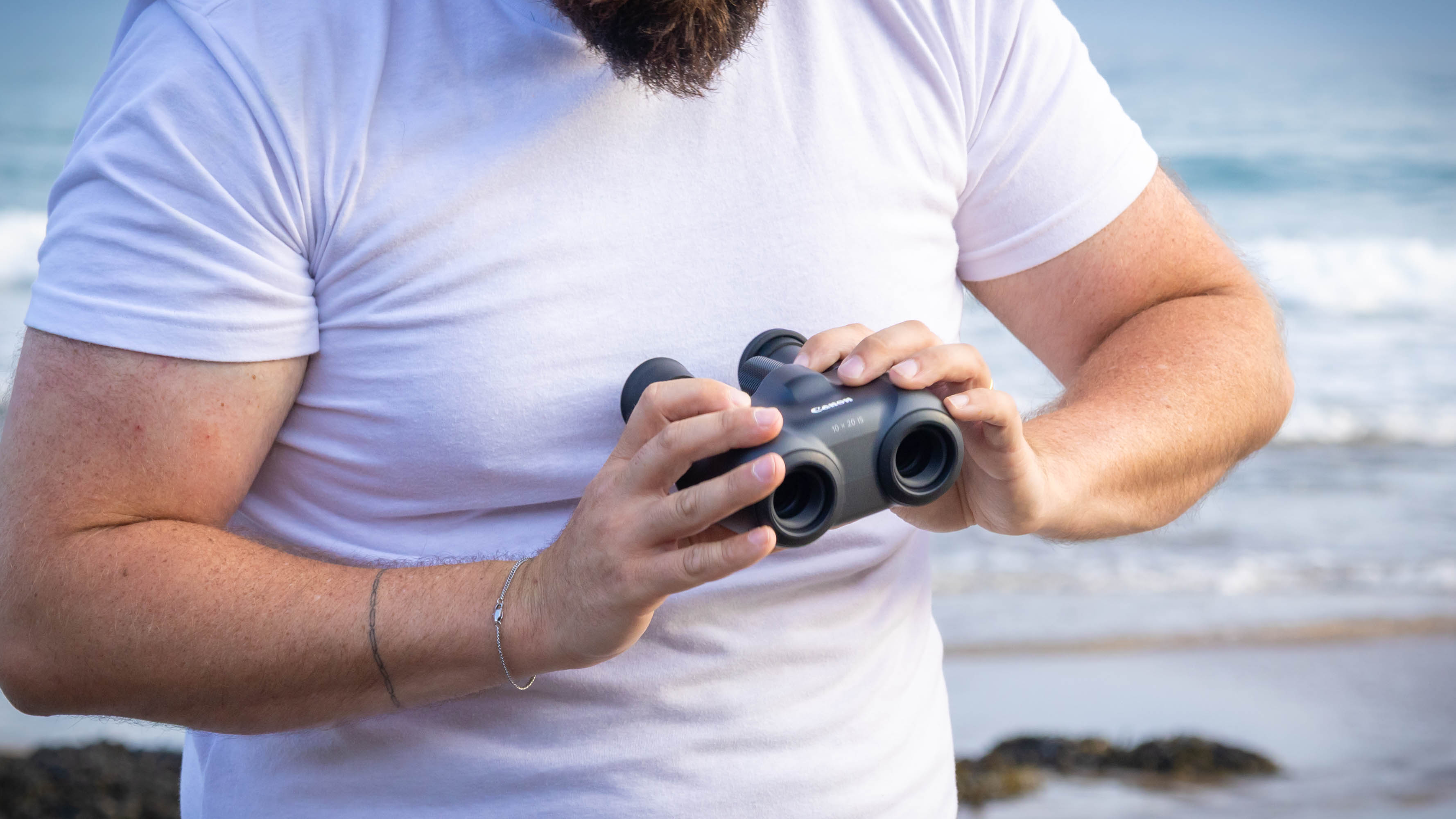
- Image stabilization aids stargazing
- Some chromatic aberration that can be excused at this price point
- Minimal coma distortion during use
You may be forgiven for expecting me to tell you these are not suitable for astronomy. After all, they are small, have only 10x magnification (better for wide-field observations) and the objectives are only 20 mm which is restrictive for the dim starlight raining down on earth. However, it’s mostly in their image stabilization that puts them firmly in the ‘good for stargazing’ camp.
The image stabilization works extremely well and holds views steady without problem. Due to this, it’s possible to observe dimmer constellations, and distant nebulas, for longer periods. The eyes adjust nicely to the dark sky and detail can be picked out even through the smaller 20 mm lenses, with these details being otherwise lost due to trembling hand movements when using traditional non-stabilized binoculars.
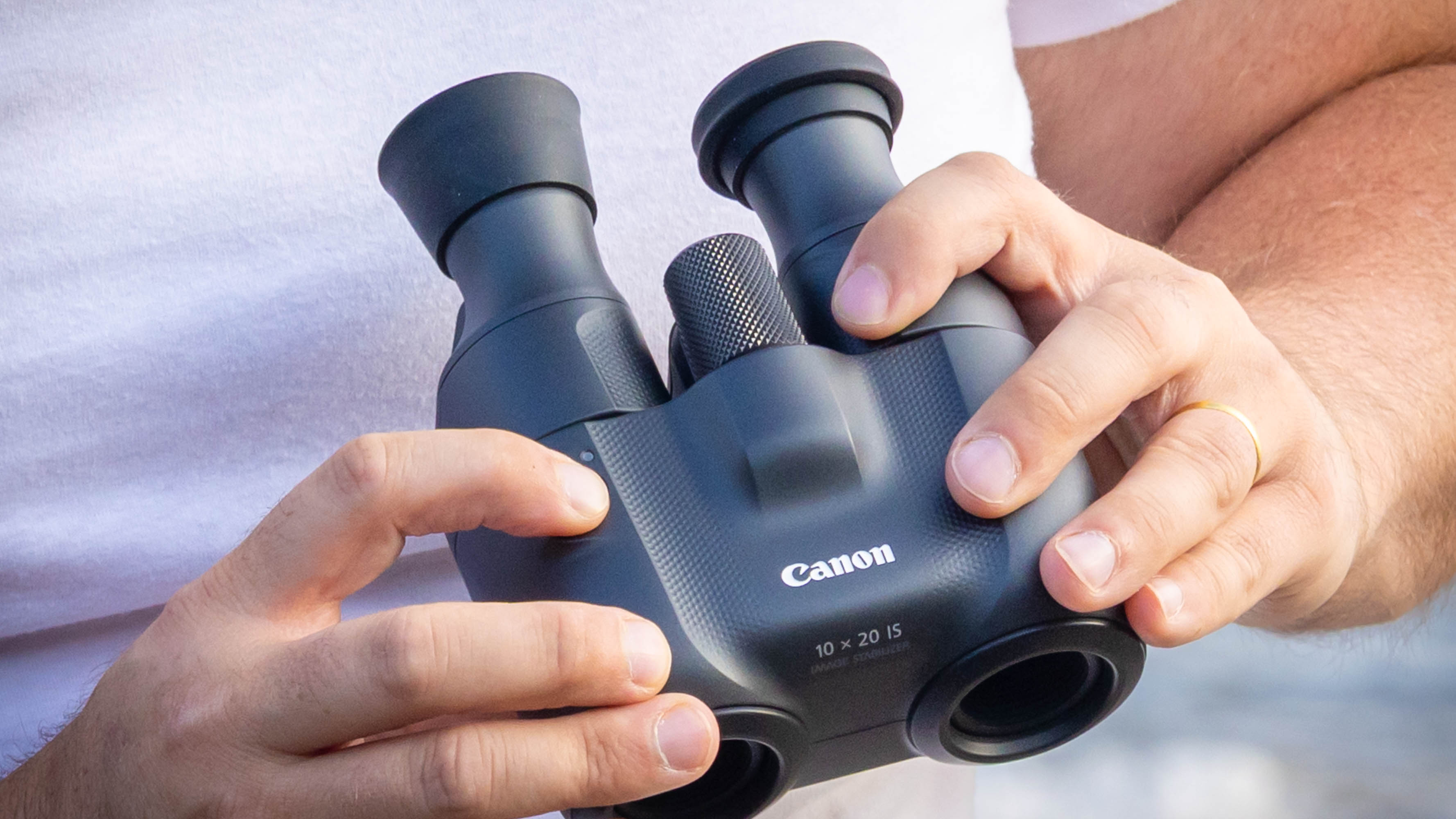
I was met with a little chromatic aberration around brighter stars and planets (Vega and Jupiter, for example), with sometimes pink and other times blue shifts around the edges of the pinpoints of light. But at this price point, for this size and the fact they feature stabilization, this can be forgiven. Coma distortion was minimal in the center of the image circle during my use stargazing, but is certainly greater towards the edges of the view. To counteract this though, I simply moved the binoculars so that my desired night sky object was in the center. It does restrict peripheral vision somewhat, making star-hopping slightly trickier to the uninitiated stargazer, but it’s not drastic enough to dissuade my recommendation.
Canon 10x20 IS: Functionality
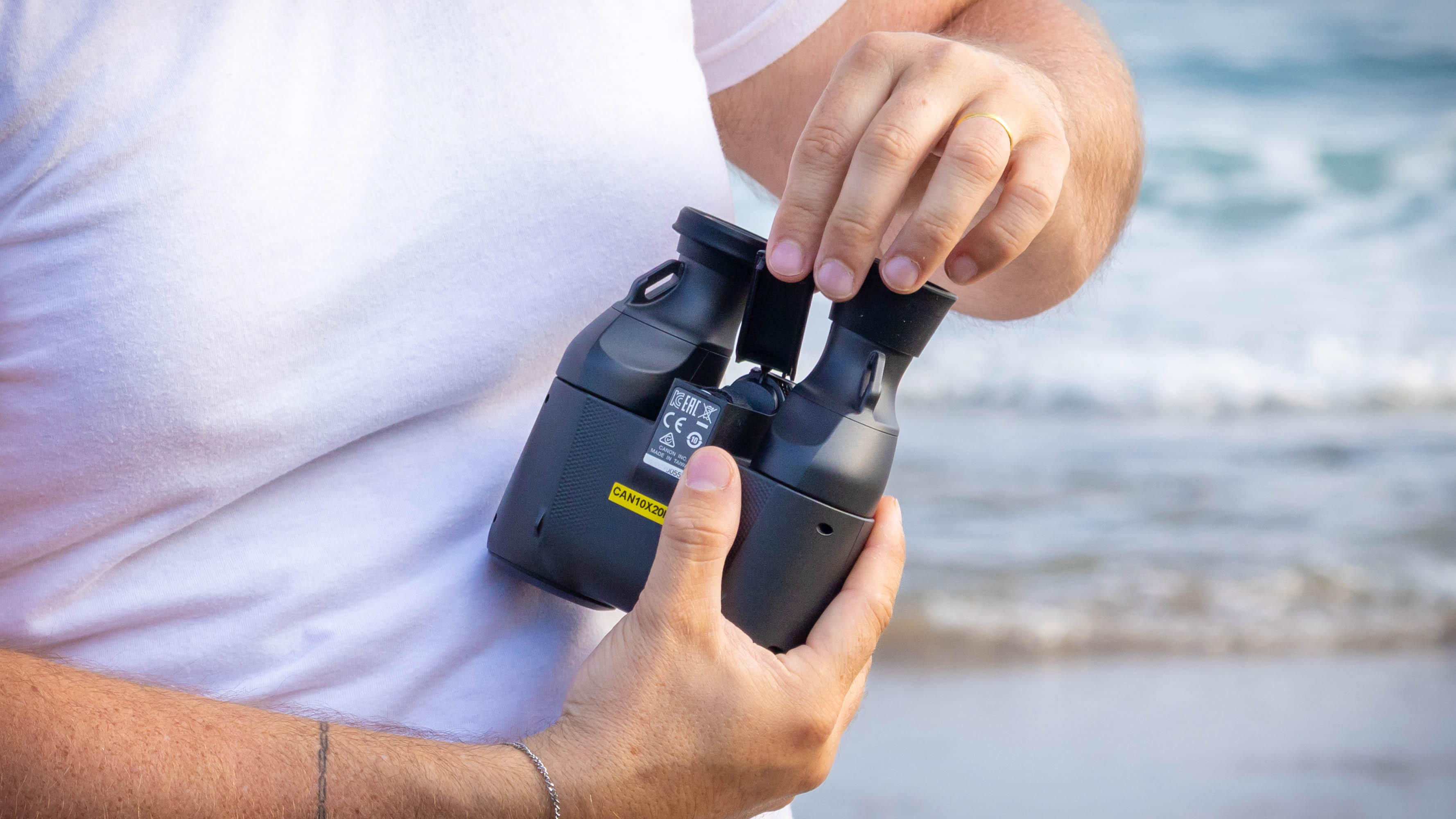
- Only two adjustments for eyecups
- Easy to hold with one hand
- No fogproofing
- Focus wheel is superb
The Canon 10x20 IS binoculars function well for stargazing and general use, like wildlife spotting during the day. They are light and small, easy to hold even with only one hand so those with grip or strength issues will benefit from this.
The rubber eyecups are comfortable but only have two adjustment points to make use of the 13.5 mm eye relief. Arguably, this isn’t quite large enough for some spectacle wearers to feel comfortable, but I found them good enough to work with my eyeglasses.
As previously mentioned, they are not waterproof (only water resistant) so do not expect to take them out in downpours. They are also not fogproof. The lack of fogproofing only proves a problem if moving between warm and cold climates (in and out of houses/a car), as internal condensation can build up before they are fully acclimatised. But since they are designed with travel in mind, I would expect most stargazers to spend enough time outside with them for this not to become an issue very often.
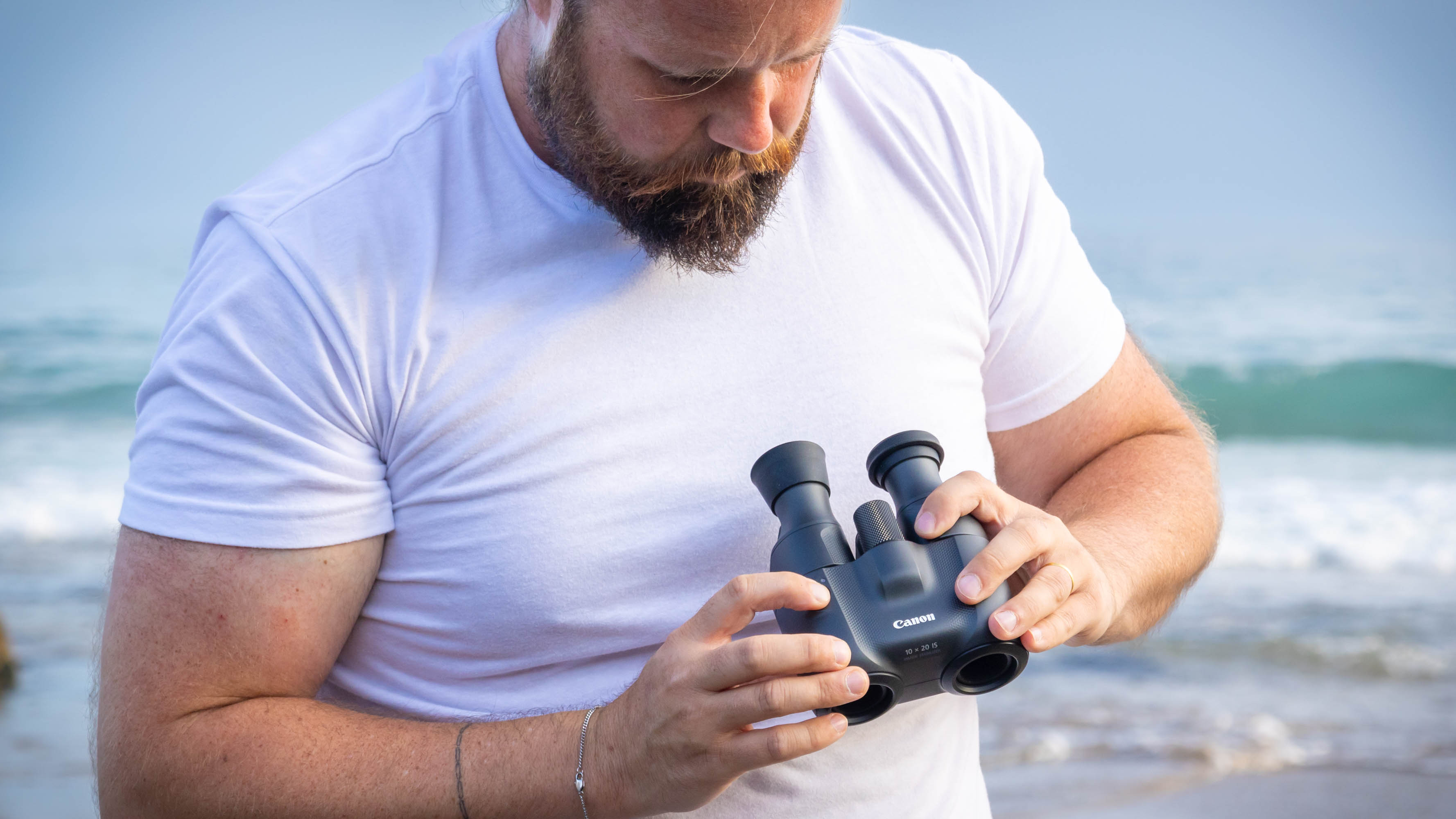
The focus wheel is superb, giving accurate and speed focus pulls when needed during daytime use and is easy to ‘set and forget’ for stargazing. I found the knurled texture easy to grip with both bare hands and gloves, with it feeling premium and smooth.
The game-changing feature is in the image stabilization (IS). Press the button on the top of the binoculars and a green light will illuminate for the entire time the stabilization remains active. After five minutes, it will automatically disengage to preserve battery, plenty long enough to observe stars between periods of rest. If you don’t want to press the button twice (and why would you? That sounds like hard work!) to turn the IS on and off, you can simply press and hold the button to keep IS active and then releasing the button will automatically disengage the stabilization without an additional press.
User reviews of the Canon 10x20 IS binoculars
Online reviews sit favorably near full marks, on average at 4.8 out of 5 stars. With one user stating, “The size and weight are wonderful: 261 grams, 9 ounces lighter than the [Canon 12x36 IS III]”.
Other users rate them for their ability to use on the water, “Great binoculars for a travel cruise! Sturdy, comfortable, and viewing stability is excellent!” which I can attest to, having used them on smaller fishing boats when observing water birds.
How we tested the Canon 10x20 IS binoculars
Used for one month, I tested the Canon 10x20 IS binoculars for stargazing in areas local to me with Bortle Classes ranging from 3-6 during the summer months. Seeing ranged from poor to fair and on the best nights, when it was good, Mars was moderately sparkling in the twilit sky. Weather was mixed with some thin stratus and fragmented cumulus, occluding views at times.
Sitting at 10x magnification, I used them mainly for constellation and asterism observations but also observed the bright summer stars in the Northern hemisphere (Vega etc) and to observe planets like Jupiter and Mars.
Should you buy the Canon 10x20 IS binoculars?
Canon fans who like to stargaze while traveling should seriously consider these binoculars. No, they’re not the traditional astronomy binocular you might expect to find in our recommendation guides, but their solid image stabilization and compact size makes them more useful than many for portable stargazing. This feature is especially useful for those with grip or strength issues or where using a tripod is not feasible.
If the Canon 10x20 IS isn't for you
Perhaps you’re not a Canon fan, or want to be able to leave your compact binoculars placed down on any old nearby flat rock and not worry about them sliding off. In that case, I’d recommend you take a look at the Nikon stabilized 12x25 compact binoculars. They, too, have good stabilization built in and are lighter again and even smaller in size thanks to their roof prism design. Views were a tad darker through these and they’re around $100 more expensive but the trade-off on size and weight is worth it.
Perhaps size or budget isnt important to you and you just want to get the best bang for your buck? In that case, I’d heartily recommend the Canon 10x42L IS WP which are also image stabilized, have a larger 10x magnification and bigger 42mm objective lenses. They are three times more expensive than the Canon 8x20 IS (around $1500 at the time of writing) but the exit pupil is large, views are generous and sharpness is perfect edge-to-edge with very minimal chromatic aberration, if any.

Jase Parnell-Brookes is the Managing Editor for e-commerce for Space and Live Science. Previously the Channel Editor for Cameras and Skywatching at Space, Jase has been an editor and contributing expert across a wide range of publications since 2010. Based in the UK, they are also an award-winning photographer and educator winning the Gold Prize award in the Nikon Photo Contest 2018/19 and named Digital Photographer of the Year in 2014. After completing their Masters degree in 2011 and qualifying as a teacher in 2012, Jase has spent the last two decades studying and working in photography and publishing in multiple areas, and specializes in low light optics and camera systems.
You must confirm your public display name before commenting
Please logout and then login again, you will then be prompted to enter your display name.

